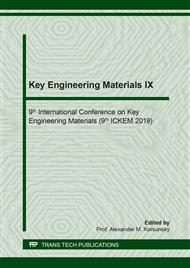p.426
p.435
p.440
p.445
p.452
p.459
p.465
p.472
p.479
Effects of Antioxidants Particle Size on Oxidation Resistance of MgO-C Refractory
Abstract:
In this study, Si and SiC powder with a critical particle size ranged from 0.1 to 0.4mm was added into MgO-C refractory as antioxidants. At 1200°C in air atmosphere, oxidation weight losses of cylindrical specimens with additives were measured and the effective diffusion coefficient of oxygen in refractories was calculated from the results. Thus, the effects of antioxidants particle size on the oxidation resistance were researched. The result shows that the particle size of antioxidant has a considerable influence on oxidation resistance of material. The oxidation resistance of MgO-C refractories increased at first as the critical particle size of Si powder increased from 0.1 to 0.2mm and then decreased as the critical particle size increased up to 0.4mm, while the oxidation resistance of MgO-C refractories decreased as the critical particle size of SiC additives increased from 0.1 to 0.4mm. The minimum effective diffusion coefficients of oxygen in MgO-C refractories added by Si and SiC were 10.90 and 14.09cm2/min, individually.
Info:
Periodical:
Pages:
452-456
Citation:
Online since:
September 2019
Authors:
Keywords:
Price:
Сopyright:
© 2019 Trans Tech Publications Ltd. All Rights Reserved
Share:
Citation:


